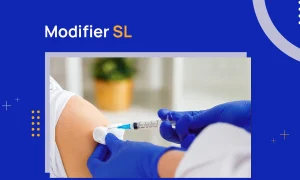Cancer used to be an incurable disease in the past. But with the advancement of science and technology, radiation therapy has become one of the most widely used treatments for cancer patients. Almost 650,000 people in the United States receive radiotherapy or chemotherapy for the treatment of cancer.
Meanwhile, many medical practices and radiation treatment providers are unaware of the appropriate CPT codes that could help in the reimbursement of their services. At NeuraBill, we have realized and decided to address this issue with our detailed guide on CPT code 77300. So, read on!
CPT Code 77300 – Description
Yes! Radiation therapy is an effective treatment for malignant tumours. However, it does have negative side effects, such as destruction of healthy tissues and surrounding structures. So, the procedure requires careful consideration of the dosage, manner, and duration of the treatment.
CPT code 77300 represents basic radiation dosimetry calculations. Now, you must be wondering what dosimetry exactly is. And what do we mean by dosimetry calculations? Let us explain it to you. Dosimetry is the calculation of the radiation dosage (the amount and time of radiation energy) required to treat a tumour successfully. The “gray” (Gy) is the unit of measurement used to calculate these doses, and it varies depending on the type and stage of the cancer being treated.
The dosimetry calculations must include:
- The central axis depth dose,
- nominal standard dose (NSD),
- time dose factor (TDF),
- gap calculation,
- off-axis factor,
- tissue inhomogeneity factor,
- And non-ionizing radiation surface and depth dosage.
Appropriate Use Cases for CPT Code 77300
To understand the practical use of CPT code 77300, let’s read these real-life scenarios.
Brachytherapy for Prostate Cancer
Let’s start with an internal radiation therapy. Suppose a 70-year-old man was diagnosed with prostate cancer at an early stage of the disease. He is supposed to undergo brachytherapy to prevent the cancer from spreading to other body parts. The physician plans his therapy with careful calculation to minimize the negative side effects of the therapy and protect other organs. In this case, he can apply CPT code 77300.
Invasive Lobular Carcinoma (ILC)
Now, let’s consider a case of invasive lobular carcinoma, which is a common type of breast cancer in women. Suppose a woman in her late 50s develops an ILC after her menopause. Her mammograms and biopsies reveal that the cancer is rapidly spreading in other parts of her body. So the healthcare provider decides to treat it through radiation therapy with a measured and calculated dose to avoid any side effects. The physician can charge for his services with CPT code 77300.
IMRT for Cervical Cancer
Let’s take a last scenario where a 68-year-old woman is diagnosed with stage 1 cervical cancer. The physician decides to conduct an intensity-modulated radiation therapy, IMRT, which uses high beams to burn the cancer cells. The oncologist plans the treatment and calculates the total number of doses required to treat the tumor. Hence, he can apply CPT code 77300 for the reimbursement of dosimetry.
Modifiers to Append with CPT Code 77300
You can break the professional and technical components of CPT code 77300 by applying the respective modifiers:
Modifier 26
You can append modifier 26 with CPT code 77300 if you are interpreting the reports, giving professional reviews, or approving the dosimetry calculations performed by a medical physicist. This modifier signifies that the physician is involved in the clinical decision-making aspect of the dosimetry process.
Modifier TC
Modifier TC is used to represent a technical component of the service. You can append modifier TC with CPT code 77300 if the radiation lab uses the mathematical and computational procedures to determine the radiation dosage distribution.
Modifier 59
A healthcare practitioner may only add this modifier to the 77300 CPT code if the services they are offering are entirely different from another service performed on the same day. We advise against the use of this modifier because many billers overuse it. Instead, modifier XE allows you to be more precise.
Reimbursement Guidelines for CPT Code 77300
Now, let’s move on to the specific reimbursement guidelines of CPT code 77300.
Prove Medical Necessity
Payers want healthcare providers to demonstrate the medical necessity of the treatments they are offering their patients. Therefore, an oncologist must give good reasons in the documentation as to why radiation therapy requires dosimetry. For example, the documents must indicate that the oncologist determined the tumor’s location and depth to ensure precise radiation therapy to the tumor site.
Follow the Medically Unlikely Edits (MUEs)
MUEs are used to report the highest unit of service (UOS) for a physician’s reported HCPCS/CPT code for the same patient on the same day. In simpler words, the NCCI has set the maximum number of units per day.
Provide Accurate Information in Documents
Of course, every physician wants to get fair reimbursement for their services. And to achieve this, billers must accurately convey all the details about the process through documentation. Since Medicare permits up to 10 IMRT beam or arc calculations per day, if the oncologist is performing more than 10 calculations, he must substantiate the necessity of the additional calculations and how they will increase the effectiveness of the treatment via clear documentation.
Final Thoughts on CPT Code 77300
CPT code 77300 represents dosimetry calculations for radiation therapies. In this blog, we explained how calculations improve the effectiveness of radiation therapies using real-life scenarios. Although modifiers are not necessary for radiation therapy planning, some conditions may require the use of modifiers, such as splitting the service into professional and technical components. In the end, to protect you from the denials, we have mentioned reimbursement guidelines that you must follow.
If you still find it difficult to bill for CPT code 77300, you can hire professional oncology billing services to file error-free claims.



